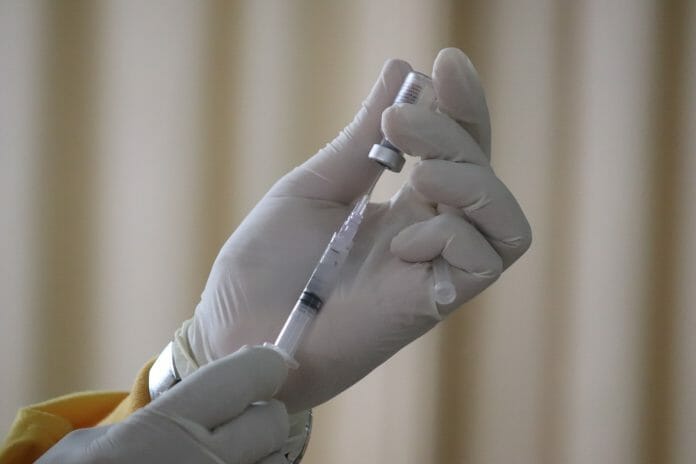By Head of Science and Technology at EMIR Research, Ameen Kamal.
At current vaccination pace, the world is set to reach a global herd immunity in an estimated average duration of seven years, as reported in The Straits Times based on Bloomberg’s estimates. Let’s look into some factors that could increase or decrease the current pace and the collective actions needed to be done by countries to overcome the hurdle.
Factors That May Increase The Global Average Vaccination Pace
Firstly, most countries are either just starting its vaccination campaigns or according to Bloomberg, two-thirds of countries have yet to even start. Countries like Canada which has ordered vaccines covering four times over its population are expected to have their vaccination rate increased once more doses arrive.
Increased vaccination efforts would also happen around the world. Vaccination rate isn’t linear and is expected to fluctuate and then increase until the countries’ respective handling/distribution threshold, which would theoretically plateau until there is an increase in manpower and infrastructure.
Vaccine production capacity is also likely to increase given worldwide demands that haven’t been met. According to FiercePharma, a pharmaceutical industry news portal, Pfizer-BioNTech increased their 2021 output target to two billion doses from 1.3 billion doses. Large advanced purchases by richer countries and the likely need for booster shots may drive other producers to scale-up production.
Lastly, as mentioned by Bloomberg, its calculator did not account for possible cases of natural immunity attained after recovering from an infection. Cases of re-infection such as recently reported in Singapore supports the need for vaccination and at the moment the impact could be minimal given that vaccination on recovered patients is still recommended, with reports mentioning at least one dose.
Factors That May Decrease The Global Average Vaccination Pace
As reported in The Straits Times, the global collective effort is held back by late deliveries of vaccines in poorer nations and by longer durations that may be required by countries with really large population such as China, India and Russia.
Another hiccup could be immunity being retained shorter than anticipated, requiring more doses faster than expected. There are reports indicating this to be a 1-year retainment, which could mean something similar to the annual flu jab. Time will tell.
There is also a real concern on the potential reduced effectiveness against continuously-emerging strains which may drive demand for new batches of updated vaccines.
For example, Malaysia’s second phase is expected to be supplied with approximately 30 percent of Oxford-AstraZeneca’s vaccine, which has been recently reported to show “disappointing” results against the South African variant.
If this remains true and the South African strain spreads in Malaysia by the second phase and if Malaysia received a non-updated version, it could set back vaccination plans. It’s been reported that other vaccine developers have observed reduced efficacy against some of the new strains.
Vaccine developers that use either mRNA or DNA technology platforms should strongly consider vaccine designs that code for parts of the virus that are much less susceptible to mutations (or in combination with the spike codes) as means to combat new strains, as was recommended in a prior article dated January 10 this year.
The above factors would exacerbate stalled vaccination plans caused by potential strains on global supply chains such as shortages in raw materials needed for increased production capacity.
According to Pharmaceutical Executives, a US-based portal on pharmaceutical and biopharmaceuticals news and analysis, production difficulties experienced by Pfizer include obtaining sterile water, laboratory equipment, lipids, chemical components and enzymes.
Throughout the global vaccination journey, we could see new short and long-term side effects or serious adverse events being reported. As more people get vaccinated and over a longer period of time, it not unusual that something unexpected emerges and derail the plan.
For example, we are now seeing cases of adverse events post vaccinations such as deaths in the frail and ill elderly, as well a rare blood disease which was not evident in clinical trials.
Lastly, children and teenagers also have to be vaccinated. So far this has been left out for the most part of vaccination strategy as vaccine testing for those below 16 are only happening now. Though children are known to be less affected by the virus (making up a small percentage of cases and less likely to show symptoms than adults), they could be “a reservoir of the virus in the population which could continue to seed further outbreaks”, as reported in MIT Technology Review.
Children vaccination is already considered in the seven-year estimate by Bloomberg and although it may not add to the timeline, it highlights how countries could have underestimated its time towards herd immunity.
What More Can Be Done?
In order to shift the global average timeline down, two impactful ways include: a) increasing vaccine production capacity with better allocations to middle-income and poorer countries; and b) increasing roll-out capacity by all countries, especially those with large population such as India, China, Russia and Indonesia.
Unfortunately, despite all talk on global solidarity, countries that are known as vanguards of global democracy and proponents of liberated economies appear to show nationalistic protectionist behaviour.
The United Nations reported that its Secretary-General António Guterres emphasised on vaccines as “global public good, available to everyone, everywhere”, and mentioned how “Vaccinationalism” is counter-productive and would slow down global recovery.
For context, according to Bloomberg data as of December last year, Canada has ordered vaccine doses that can cover 410 percent of its population, followed by the U.K. at 295 percent and Australia at 269 percent. These are the top three and all subsequent top 30 countries have ordered doses that cover 120 percentor more of their population.
When comparing this with the current state of poorer nations, the widely-touted “equitable access to vaccines” is evidently mere lip-service, if not outright hypocritical.
As jointly reported by prominent economists Professor Jomo Kwame Sundaram and Professor Anis Chowdhury, more than 85 poor nations will not have sufficient vaccine access before end of 2023 at current rates and only 10 percent of the population will be vaccinated in 70 lower income countries. In a stark contrast, richer countries with only 16 percent of the world population has secured nearly 60 percent of available doses.
“Vaccinationalisism” is further fuelled by scarcity, which, as jointly pointed out by both economists, may have been further contributed by intellectual property (IP) rights of Covid-19 vaccines. They referred to the combination of IP and ‘vaccine warfare’ as ‘lethal’, contributing to loss of lives and livelihoods.
That being said, it is also true that vaccine and drug makers have spent considerable time and resources and therefore, it’s reasonable to be rewarded for producing innovative products that could end the outbreak. However, it is also a fact this is not a normal situation and thus, surely there must be humanitarian grounds for special considerations, at least in terms of temporary measures, in light of a global health crisis.
Anyways, the debate on IP rights as a mechanism that could either promote or hinder innovation to benefit the many is a discourse for another time.
Regardless of debate outcomes, nations should always stand with the truth and stand up for what’s right. Especially what’s right for the many. Thus, Malaysia should find a way to be fully supportive of equitable vaccine access to low-income and middle-income countries, but in a strategic way.
Whether this is through supporting the patent waiver proposal presented to the World Trade Organization (WTO) Trade-Related Aspects of Intellectual Property (TRIPS) or other means, it’s up to the economists, foreign relations, trade, health and legal experts to formulate balanced strategic moves for Malaysia.
As reported in The Lancet, the TRIPS waiver calls for temporary suspension on IP rights on Covid-19 vaccines and other new technologies, claiming that it would ultimately allow better (cheaper and faster) access to vaccines and other related technologies by poorer countries.
It’s been reported that Malaysia’s National Covid-19 Immunisation Programme, led by Minister of Science, Technology and Innovation Khairy Jamaludin has gained the government’s approval to include free vaccination for both its citizens and non-citizens – a micro example of logical economic and humanitarian consideration that goes beyond borders which could be emulated by TRIPS Council members and other countries towards true global solidarity.









